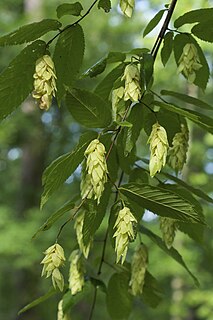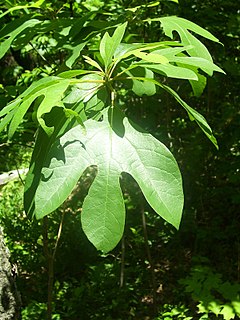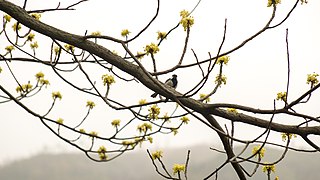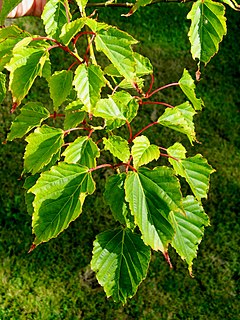
Trillium is a genus of about fifty flowering plant species in the family Melanthiaceae. Trillium species are native to temperate regions of North America and Asia, with the greatest diversity of species found in the southern Appalachian Mountains in the southeastern United States.

Quercus muehlenbergii, the chinkapin or chinquapin oak, is a deciduous species of tree in the white oak group. The species was often called Quercus acuminata in older literature. Quercus muehlenbergii is native to eastern and central North America. It ranges from Vermont to Minnesota, south to the Florida panhandle, and west to New Mexico in the United States. In Canada it is only found in southern Ontario, and in Mexico it ranges from Coahuila south to Hidalgo.

Sassafras is a genus of three extant and one extinct species of deciduous trees in the family Lauraceae, native to eastern North America and eastern Asia. The genus is distinguished by its aromatic properties, which have made the tree useful to humans.

The flowering plant family Lauraceae, the laurels, includes the true laurel and its closest relatives. This family comprises about 2850 known species in about 45 genera worldwide. They are dicotyledons, and occur mainly in warm temperate and tropical regions, especially Southeast Asia and South America. Many are aromatic evergreen trees or shrubs, but some, such as Sassafras, are deciduous, or include both deciduous and evergreen trees and shrubs, especially in tropical and temperate climates. The genus Cassytha is unique in the Lauraceae in that its members are parasitic vines.

Cinnamomum is a genus of evergreen aromatic trees and shrubs belonging to the laurel family, Lauraceae. The species of Cinnamomum have aromatic oils in their leaves and bark. The genus contains over 300 species, distributed in tropical and subtropical regions of North America, Central America, South America, Asia, Oceania, and Australasia. The genus includes a great number of economically important trees.

Ocotea is a genus of flowering plants belonging to the family Lauraceae. Many are evergreen trees with lauroid leaves.

Quercus imbricaria, the shingle oak, is a deciduous tree in the red oak group of oaks. It is native primarily to the Midwestern and Upper South regions of North America, from southern New York west to northern Illinois and eastern Kansas, and south to central Alabama and Arkansas. It is most commonly found growing in uplands with good drainage, less often along lowland streams, at 100–700 m altitude.

Quercus dentata, also called Japanese emperor oak or daimyo oak is a species of oak native to East Asia. The name of the tree is often translated as "sweet oak" in English to distinguish it from Western varieties.

Castanea mollissima, also known as the Chinese chestnut, is a member of the family Fagaceae, and a species of chestnut native to China, Taiwan, and Korea.
Ulmus glaucescensFranch., the Gansu elm, is a small deciduous tree from the northern provinces of China, where it is found along river valleys and on mountain slopes at elevations of 2000–2600 m.

Ostrya virginiana, the American hophornbeam, is a species of Ostrya native to eastern North America, from Nova Scotia west to southern Manitoba and eastern Wyoming, southeast to northern Florida and southwest to eastern Texas. Populations from Mexico and Central America are also regarded as the same species, although some authors prefer to separate them as a distinct species, Ostrya guatemalensis. Other names include eastern hophornbeam, hardhack, ironwood, and leverwood.

Sassafras albidum is a species of Sassafras native to eastern North America, from southern Maine and southern Ontario west to Iowa, and south to central Florida and eastern Texas. It occurs throughout the eastern deciduous forest habitat type, at altitudes of up to 1,500 m (4,900 ft) above sea level. It formerly also occurred in southern Wisconsin, but is extirpated there as a native tree.

Hamamelis virginiana, known as witch-hazel, common witch-hazel, and American witch-hazel, is a species of flowering shrub native to eastern North America, from Nova Scotia west to Minnesota, and south to central Florida to eastern Texas.

Trillium albidum, also known as giant white wakerobin, white toadshade, and sweet trillium, is a species of flowering plant in the family Melanthiaceae. The species is endemic to the western United States, ranging from west central California through Oregon to Washington. It is found in diverse habitats, on the moist slopes of mixed deciduous-coniferous forests, among shrubs and thickets, and along stream banks and river beds.

Sassafras hesperia is an extinct species of flowering plant in the family Lauraceae.

Eucommia is a genus of small trees now native to China, with a fossil record that shows a much wider distribution. The single living species, Eucommia ulmoides, is near threatened in the wild, but is widely cultivated in China for its bark, and is highly valued in herbology such as traditional Chinese medicine.

Neolitsea sericea is a species of tree in the family Lauraceae. It is found in China, Taiwan, south Korea, and Japan. Its natural habitat is on forest margins and slopes, and it is often found in well-progressed secondary forests.

Sassafras tzumu is a species of Sassafras native to China, in Anhui, Fujian, Guangdong, Guangxi, Guizhou, Hubei, Hunan, Jiangsu, Sichuan, Yunnan and Zhejiang. It grows in either sparse or dense forests habitat types, at altitudes of 100–1900 meters.

Cinnamomum kanehirae, also known as small-flowered camphor tree, or stout camphor tree, is a tree within the genus Cinnamomum of the family Lauraceae endemic to Taiwan.

Acer morrisonense is an Asian species of maple found only in the mixed forests of eastern and southern Taiwan, at elevations of 1800 – 2200 m. The species is sometimes confused with another Taiwanese tree, Acer caudatifolium.




















